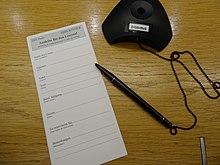Loan slip

A loan slip is a library document used to document a loan process in writing.
In many libraries, the loan form replaced loan lists kept in books. The listing of loan transactions on individual notes enabled flexible sorting and thus the management of larger library holdings. In turn, the loan slip was replaced by punch cards in some libraries and software in others. An integrated library system is usually used for this.
However, loan tickets are still in use, including for magazine orders or reading room loans.
Red loan slip
The so-called red loan certificate is used by libraries to process interlibrary loans . The title of the desired work and other data necessary for processing are entered on the red loan slip, for example the maximum costs borne by the ordering party or libraries that have the work in their inventory. The loan slip is then sent to the owning libraries, which then hand it over to the ordering library together with the work. The use of computerized interlibrary loan systems makes the red loan slip less important.
Loans in research
By evaluating historical loan tickets, it is possible to determine which literature has been read, for example, by writers or scientists.
Individual evidence
- ^ Wilhelm Gaus: Documentation and Ordnungslehre: Textbook for the theory and practice of information retrieval . Springer, Berlin, Heidelberg 1983, ISBN 3-662-06763-3 , pp. 505 .
- ^ Walter Lingenberg: About the use of punched card procedures in libraries . Greven, Cologne 1955, p. 85 .
- ↑ See also interlibrary loan (including illustration) on the Oldenburg State Library's website .
- ^ Engelbert Plassmann: Libraries and Information Society in Germany: An Introduction . 2., thoroughly revised. and exp. Edition. Harrassowitz, Wiesbaden 2011, ISBN 978-3-447-06474-3 , pp. 192 f .
- ↑ The only surviving loan from Goethe (the loan is in the possession of the Goethe and Schiller Archives. On October 15, 1828, Goethe borrowed Nikolaus Joseph von Jacquin , Hortus Schoenbrunnensis, 2 volumes.) . Böhlau, Weimar 1932, p. 1 .